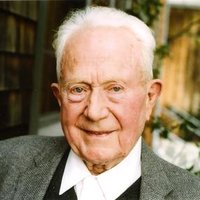
Heinz Otto Cordes
Professor of Mathematics, Emeritus
Heinz Otto Cordes passed away on October 30, 2018 after spending 62 years in Berkeley. He was born on March 18, 1928 in Westfalen, Germany. He received his doctorate (Dr.rer.nat.) from Georg-August-Universität Göttingen in 1952, under the supervision of Franz Rellich, with a thesis titled “Separation der Variablen in Hilbertschen Räumen.” He continued on at Göttingen for four years and in 1956 was appointed assistant professor at the University of Southern California. In response to interest from UC Berkeley, USC offered him a tenured associate professorship. However, Berkeley prevailed, and he accepted a position of assistant professor, effective July 1, 1958. He was promoted to tenured associate professor in 1959 and to professor in 1963. Professor Cordes retired in 1991 under the university’s voluntary early retirement program. Only age 63 at the time, he continued his research throughout his retirement.
Cordes’s research was devoted to partial differential equations (PDE), and he made a number of significant advances in this area. Early influential work included results on unique continuation for second-order elliptic PDE with rough coefficients and early progress on rough elliptic PDE in non-divergence form. It was the famous Aronszajn–Cordes uniqueness theorem (obtained independently by Nachman Aronszajn) that attracted the attention of Charles Morrey and resulted in bringing Cordes to Berkeley.
In later work, Cordes introduced C*algebra techniques as a method to define the symbol of elements of algebras of singular integral operators (or pseudodifferential operators), extending symbol calculus from the setting of compact manifolds to various classes of non-compact manifolds. This work segued into a study of Dirac operators, with particular attention to connections with quantum mechanics. His interest in problems in PDE related to quantum mechanics occupied him well past retirement. He produced over 60 publications, including four monographs. Recognition for his work included an Alfred P. Sloan fellowship in 1959. He was invited to address the International Congress of Mathematicians in 1966, but he declined.
During his time at Berkeley, Professor Cordes supervised 19 graduate students, and quite a few of them, and subsequently their students, became leaders in PDE. Michael Crandall (Ph.D. '65), following his advisor’s suggestion, solved a problem posed by Siegel about periodic solutions of the planar four-body problem as perturbations of the Lagrange triangle solution of the three-body problem. Michael Taylor (Ph.D. '70) wrote his dissertation on hypoelliptic differential equations, and in addition to many scientific contributions (which had a profound impact on the work of many, including the author of this article) became one of the most prolific textbook writers on PDE. Robert Moyer (Ph.D. '64) became famous for his idea of proving the necessity of the Nirenberg–Treves’s condition, which was eventually established by Hörmander.
Heinz Cordes visited Lund during the 1971-72 academic year and gave a course on pseudodifferential operators from the C* point of view. Across decades, Johannes Sjöstrand recalls that course and Cordes' warmth toward students, especially recent graduates David Tartakoff (Ph.D. '69) and Mike Taylor (Ph.D. '70). In what was probably unusual at the time, at the end of that semester he invited his students to a restaurant. During his stay in Lund, Cordes spent weekends in Northern Germany with his family.
Arne Jensen, who spent part of the late 1970s at Berkeley working with Tosio Kato, recalls the deep friendship between Cordes and Kato. He also mentions the warm and charmingly old-fashioned hospitality that he enjoyed at the Cordes home.
In his fifties, Cordes became a passionate sailor. He had a 40-foot boat that his three children helped him sail to Hawaii and back. Later in life, he was not able to maintain the boat in its former glory, and although he occasionally found three mathematicians as crew, the boat stayed mostly in its slip and slowly decayed. Eventually, he found a well-known sailor who was successful in restoring the boat. A new crew sailed the boat to Hawaii and back in a recent Transpacific Yacht Race.
Heinz Cordes is survived by his wife of 63 years, Hillgia Cordes, and two sisters, Irmtraud Salmen and Frohmut Moermel. Hillgia and Heinz had been through a lot together, including emigrating to the United States with $50 in their pockets. Initially they thought they would return to Europe, but they fell in love with California and UC Berkeley. Their children followed in their father’s footsteps with regards to his love of science and technology. Their son, Stefan, is a former string theorist (not approved by Cordes senior!) who subsequently went to medical school; he is currently a physician/scientist at the National Institute of Health. Their daughter, Sabine, is a developmental neurobiologist in Toronto. The youngest daughter, Eva, works in technology, using big data for sustainable agriculture.
Maciej Zworski
2020
